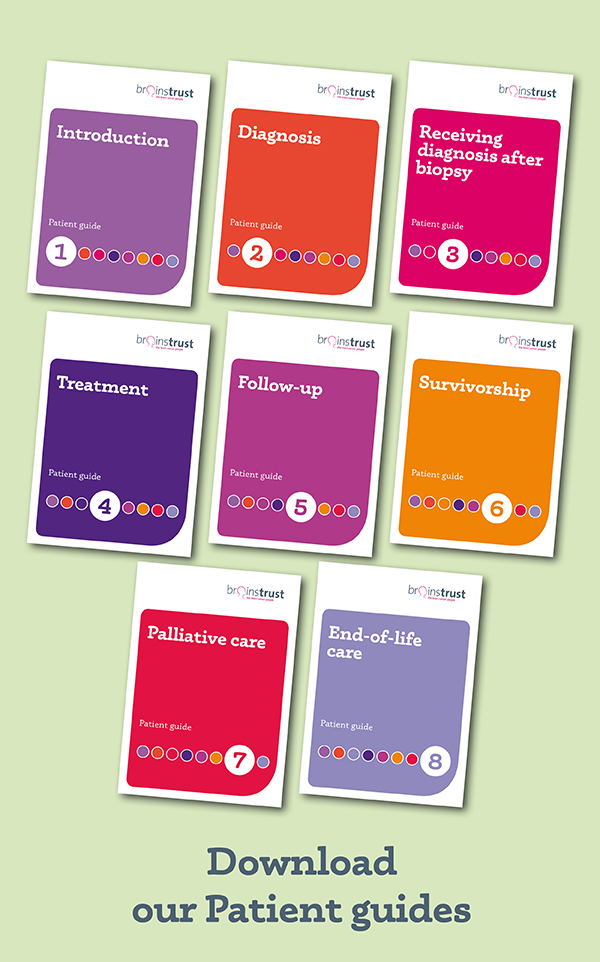Types of neurosurgery
Following a brain tumour diagnosis, one of the treatment options that you will be offered may include neurosurgery. There are several different types of neurosurgery, on this page we explain the different types.
The type of neurosurgery that you will be offered will be dependent on many factors including tumour type and location. This will all be discussed with you by your clinical team beforehand.
On this page, you will find information about some of the different types of neurosurgery that are offered to people following a brain tumour diagnosis. This information, combined with our Patient Guides, will help you to feel better resourced and more engaged with your clinical care.
An awake craniotomy is an operation performed in the same manner as a conventional craniotomy but with the patient awake during the procedure. This is a preferred technique for operations to remove lesions close to, or involving, eloquent (functionally important) regions of the brain. This allows us to test regions of the brain before they are incised or removed and allows us to test patient’s function continuously throughout the operation. The overall aim is to minimise the risks of such operations.
How is an awake craniotomy performed?
There are different techniques but the most commonly used here is described. In the anaesthetic room you will have a drip inserted with some drugs that make you feel comfortable and relaxed. In theatre, the neuronavigation system will then be used to mark out the incision and a very small amount of hair shaved along the line of the incision before it is cleaned with antiseptic solutions and then local anaesthetic is inserted around the incision. This will sting a little for a few seconds and then go numb.
Some drapes are placed around the wound but you will be able to see the anaesthetic team and talk to them and be able to move your arms and legs freely during the operation. The operation then continues and you will hear some noises and the drilling sound briefly.
When the brain is exposed we will perform a procedure called cortical mapping. This involves stimulating the brain surface with a tiny electrical probe. If we stimulate a motor region of the brain it may cause twitching of a limb or your face; a sensory area will cause a tingling feeling; the speech areas will prevent you from speaking very briefly. By mapping out the important regions of the brain first we can aim to avoid and protect them during the operation. Whilst we remove the tumour we will continuously test your function, and if anything changes we will be able to stop.
This does not eliminate the risks of surgery but does likely reduce them.
After the tumour has been removed, all bleeding is stopped, the dura is closed with sutures, the bone is replaced with 3 mini-plates and the scalp is closed. The skin is closed with staples, the wound is dressed and often a head bandage is applied.
This procedure will be performed either with a general anaesthetic or sedation (see awake craniotomy).
In the operating theatre you will be positioned on an operating table and your head will be supported by a headrest. The neuronavigation system (like a satellite navigation system) will then be used together with your pre-operative scan data to precisely locate the site for the tumour (target) and to determine an entry point, which can then be marked on the scalp. A small incision can then be marked on the scalp and a very small amount of hair shaved along the line of the incision before it is cleaned with antiseptic solutions and then surrounded by surgical drapes. A small injection of local anaesthetic is used: this stings for a few seconds only if you are awake.
The skull is exposed by making an incision in the scalp and then a high-speed drill is used to make a small burr hole through the skull to reveal the underlying dura (the outermost layer of the brain). A special drill (craniotome) is then used to cut a disc of bone, which is removed from the dura. The dura can then be incised to reveal the underlying brain (and tumour). If the tumour lies on the surface of the brain (e.g. a meningioma) it is carefully dissected from the brain and removed. If the tumour lies within the brain substance then it is necessary to incise the surface of the brain and open the brain down onto the surface of the tumour and then the mass can be removed.
For some tumours it is possible to remove the entire tumour and likely produce a cure (e.g. meningioma). This is called a gross total resection. For many intrinsic brain tumours the surgeon aims to remove as much of the tumour as possible (and safely) but there will inevitably be microscopic remnants of the tumour in the surrounding brain (e.g. glioma).
After the tumour has been removed, all bleeding is stopped, the dura is closed with sutures, the bone flap is replaced with 3 mini-plates and the scalp is closed. The skin is closed with staples, the wound is dressed and often a head bandage is applied. It’s all done!
This technology was pioneered by Prof. Peter Black. This technique supports neurosurgeons in the attempt to enhance resection, even in the most delicate and inaccessible areas of the brain. Sometimes it is difficult for a surgeon to distinguish the tumour from the tissue surrounding it. It does not make a neurosurgeon a better neurosurgeon; it’s just another tool to be used.
An intraoperative MRI works between the magnets in the open space, which is an operating theatre. Because the magnets can be used at any time during the surgery real time images of the brain can be seen as the surgeon operates. The extent of the resection can be monitored with periodic images throughout, which ensures a more accurate resection and is safer because any brain bleeds can be dealt with quickly.
This technology is now available in the UK. To find out more, speak to your consultant or clinical team.
This is a new technique and sometimes using lasers can help to remove a brain tumour. Laser interstitial thermal therapy (LITT) uses an MRI-guided laser probe, passed through a small bur hole in the skull, to deliver heat and coagulate the tumour from the inside. It involves a craniotomy.
It is not available on the NHS for the treatment of brain tumours. It is not likely to make inoperable tumours removable and there is no good quality evidence to show that lasers improve the safety and efficiency of surgery.
Did this information make you feel more resourced, more confident or more in control?
Date published: 17-05-2009
Last edited: 05-2025
Due for review: 05-2028













